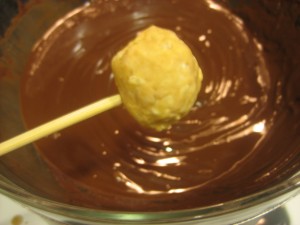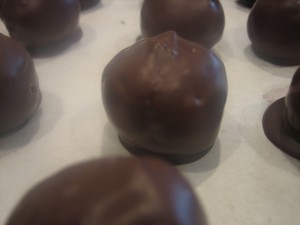I had no idea. Really, I didn’t.
What began as a (self-deemed) creative attempt at gift giving has turned into a burgeoning obsession. The French macaron. How I hate thee. And love thee. And hate thee. To make matters worse, the little buggers have begun to show up everywhere. Haunting me. Whereas months ago I’d never even seen one outside of the recipe books, they’re now stalking me from magazine covers, bake shops and Starbucks. That’s right, Starbucks is selling them. Sheesh.
And they aren’t cheap. There is a store in Beverly Hills that only sells French macarons. The price: $1.60 a piece. This has me knocking my head against the wall and (not for the first time) asking myself…why…why did I not think of this 12 months earlier? I’d have the market cornered and would certainly be well on my way to appearing in the Forbes top gagillionaires under 40 list.
But, I didn’t. And so I probably won’t.
Here is how my relationship with the French macaron began. Over the summer I read David Lebovitz’s The Sweet Life in Paris http://www.davidlebovitz.com/books/. Now, I don’t know where Mr. Lebovitz has been all my life, but man, I’m glad he’s in it now. If you don’t already know (and you probably do), he was a pastry chef at Chez Panisse and now lives in Paris and writes cool cookbooks and a really funny blog http://www.davidlebovitz.com/. The Sweet Life is sort of a living memoir with recipes. And, as soon as I read it, I knew I had to give it as a holiday gift. What better to pair the book with than with a bag of the quintessential French treat (and there is a recipe for them in the book), that’s right, le macaroon Françoise (made by me of course).
Ha!
Are you getting the feeling that my seminal adventures with this sandwich cookie may not have been entirely successful?
Turns out, there is a reason that little shop sells them for nearly two dollars each. Much like the Parisians themselves (yes, I am about to stereotype), they are fussy, finicky and rather unpredictable. But, I’ll admit, also like the city of lights and its culture, the entity (when it does turn out) is worth the hassle.
So, this is my first of who knows how many posts on French macarons. I am determined to get them right. And, I am determined to try each and every flavor (except for the ones I don’t think I’ll like because, really, what would be the point?). Right now, my success rate is about 50%–but I promise to share my successes and failures along the way.
To start, this recipe calls for not only a food processor but also a standing mixer (or some really strong biceps that can create stiff peaks with a whisk). The recipe also necessitates a pastry bags and tips. This is indeed a gadgety recipe.
Next, you make your own flour. Yep, flour from blanched almonds. Using food gadget #1, the food processor (mine’s named Bertha), grind the almonds into a powder. You want the mixture to be super duper fine. I got it as fine as I could. I’ve recently read that you should sift the flour a couple of times after grinding. I’ll try that next time and report back.
To continue with a theme, you then grind together the almond flour, confectioner’s sugar and cocoa.
So as not to make the standing mixer jealous (yes, this too has a name: Marta), egg whites are whipped into lovely silky peaks. A couple of my batter attempts turned out very dry (more on this later). In retrospect, I think I must have over-whipped the egg whites and sugar.
Once you’ve got peaks, very carefully fold in the dry mixture. I’ve read that the resulting batter should act like lava. Indeed, I believe this is an apt description. The batter is definitely liquidy but also has a certain viscosity.
Once you’ve corralled the batter into a pastry bag, pipe disks onto parchment-lined baking sheets. And, into the oven they go. But wait, there seems to be some speculation on whether to let the raw batter harden some before going in to the oven. I think this may make a difference if you live in a humid environment. In dry Southern California the disks were already beginning to harden as I finished each sheet.
Remember my mention of over-whipping the eggs whites.? Look at the picture below, specifically the, uhm, piles ones on the right. What do they look like? Uhhuh. On the over-whipped batch they piped out in coils and baked in the same form. My husband was incredibly amused and I apologize to anyone who may have been the recipient of a “liberated” french macaron.
Done right, the cookies have “feet” and do not crack or split across the top. Lets talk about the feet first. Take a look at the picture below. See the little base at the bottom? Those are feet. If your cookies crack, they won’t grow feet. And apparently that is a major macaron faux pas.
Through trial and error I discovered that I could only use the top rack in my oven. Lower racks caused the cookies to crack.
After they are nice and cool, you marry up the halves. Fill them (this time around I used a chocolate ganache–though not the one David Lebovitz has with his recipe).
Et voila, you are one step closer to speaking French.
From The Sweet Life in Paris (Broadway) by David Lebovitz
http://www.davidlebovitz.com/archives/2005/10/french_chocolat.html
Batter
- 1 cup (100 gr) powdered sugar
- ½ cup powdered almonds (about 2 ounces, 50 gr, sliced almonds, pulverized)
- 3 tablespoons unsweetened Dutch-process cocoa powder
- 2 large egg whites, at room temperature
- 5 tablespoons granulated sugar
Preheat oven to 350º F .
Line two baking sheets with parchment paper and have a pastry bag with a plain tip (about 1/2-inch, 2 cm) ready.
Grind together the powdered sugar with the almond powder and cocoa so there are no lumps; use a blender or food processor since almond meal that you buy isn’t quite fine enough.
In the bowl of a standing electric mixer, beat the egg whites until they begin to rise and hold their shape. While whipping, beat in the granulated sugar until very stiff and firm, about 2 minutes.
Carefully fold the dry ingredients, in two batches, into the beaten egg whites with a flexible rubber spatula. When the mixture is just smooth and there are no streaks of egg white, stop folding and scrape the batter into the pastry bag (standing the bag in a tall glass helps if you’re alone).
Pipe the batter on the parchment-lined baking sheets in 1-inch (3 cm) circles (about 1 tablespoon each of batter), evenly spaced one-inch (3 cm) apart.
Rap the baking sheet a few times firmly on the counter top to flatten the macarons, then bake them for 15-18 minutes. Let cool completely then remove from baking sheet.
Match up pairs and fill with ganache.
Chocolate ganache (recipe by Martha Stewart)
note: I used this recipe not because I don’t like Mr. Lebovitz’s but because I had made this ganache recipe a couple of days before for sundaes and just tripled the batch at the time…you know, kill a couple of birds with diabetes at once.
- 4 cups heavy cream
- 2 pounds best-quality semisweet chocolate, finely chopped
- 1/4 cup light corn syrup
- 1/4 teaspoon salt
In a small heavy sauce pan, bring cream to boil over medium heat. Remove from heat and add chocolate, swirling the pan so the chocolate is completely covered. Wait a couple of minutes and carefully mix the chocolate and cream together with a spatula. Mix in corn syrup and salt. Transfer to a clean bowl and refrigerate until the consistency of fudge (this makes filling the cookies easier).
























